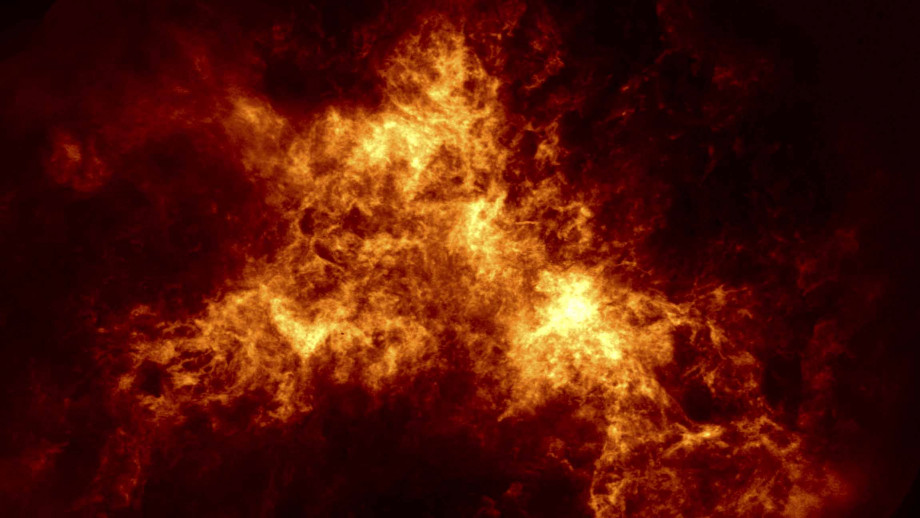
Atomic hydrogen gas in the Small Magellanic Cloud as imaged with our Australian Square Kilometre Array Pathfinder. The Small Magellanic Cloud, located only 200,000 light-years away, is one of our nearest galactic neighbours and visible to the naked eye in the Southern sky. Credit: N. McClure-Griffiths (ANU), H. Denes (CSIRO), J. Dickey (UTas) and the ACES and GASKAP teams.
The galaxy sweet galaxy that we call home, the Milky Way, is comprised of around 200 to 400 billion stars. A dwarf galaxy, on the other hand, is one that has around 100 million up to several billion stars. In fact, one of our closest neighbours is a dwarf galaxy – the Small Magellanic Cloud – and our new Australian Square Kilometre Array Pathfinder (ASKAP) telescope has just made the most detailed radio image of it yet.
The Small Magellanic Cloud is a hundred times smaller than the Milky Way and orbits our Galaxy once every 1.5 billion years. You can see it with your own eyes if you are away from city lights, it looks like a faint cloud among the Milky Way’s stars.
Unlike optical telescopes such as the Hubble Space Telescope that collect visible light, radio telescopes use radio waves to form a picture and reveal otherwise hidden details in space.
This new image was snapped using ASKAP’s fast-imaging ‘radio cameras’ known as phased array feeds. It reveals the galaxy’s vibrant history, including streams of hydrogen gas reeled in by the gravitational pull of our own Milky Way galaxy and billowing voids generated by massive stars that exploded millions of years ago.

Our ASKAP radio telescope at the Murchison Radio-astronomy Observatory in Western Australia.
Professor Naomi McClure-Griffiths from the ANU Research School of Astronomy and Astrophysics, who jointly led the work with Professor John Dickey of the University of Tasmania, says the new image shows that the Small Magellanic Cloud’s very dynamic past can be used to predict its future.
“Hydrogen is the fundamental building block of all galaxies and shows off the more extended structure of a galaxy than its stars and dust.”
“The outlook for this dwarf galaxy is not good, as it’s likely to eventually be gobbled up by our Milky Way,” she said.
The previous ‘best’ radio image of the Small Magellanic Cloud was made with another of our telescopes, the Australia Telescope Compact Array. That telescope had to be pointed in 320 different places across the face of the galaxy over eight nights.
By contrast, this new image was made in one shot – over three nights – using only 16 of ASKAP’s 36 receivers. The result covers a larger area of the sky than previously achieved, revealing more of the outer parts of the Small Magellanic Cloud. Data from our Parkes radio telescope was also added to pick up faint details.
So the new image is bigger, has finer detail, and is more sensitive than previous radio images of the Small Magellanic Cloud.
According to Dr Phil Edwards, leader of our astronomy science program, this is just a taste of what’s to come. “This stunning new image showcases the wide field-of-view of the ASKAP telescope. The depth of our images will only get better when the full array comes online next year.”
ASKAP is part of the Australia Telescope National Facility which is managed by CSIRO. Operation of ASKAP is funded by the Australian Government with support from the National Collaborative Research Infrastructure Strategy. ASKAP uses the resources of the Pawsey Supercomputing Centre. Establishment of ASKAP, the Murchison Radio-astronomy Observatory and the Pawsey Supercomputing Centre are initiatives of the Australian Government, with support from the Government of Western Australia and the Science and Industry Endowment Fund. We acknowledge the Wajarri Yamaji people as the traditional owners of the Observatory site.


16th December 2017 at 6:41 pm
yeah, it’s the whole thing
14th December 2017 at 7:52 pm
one of the best images after hubble’s first brilliant images almost got us used to the dramatic until this came along
29th November 2017 at 5:54 pm
This is like a large bush fire. Is it possible for me to get an idea of the solid angle this image covers this 200000light year distance from SAKAP. I hope I am clear here in what I am asking. Does this picture cover the whole galaxy Small Megellanic Cloud.
Pingback: Allgemeines Live-Blog ab dem 21. November | Skyweek Zwei Punkt Null
Pingback: ASKAP helps us see more of our intergalatic neighbour – MeasurementDataBases for Industry & Science